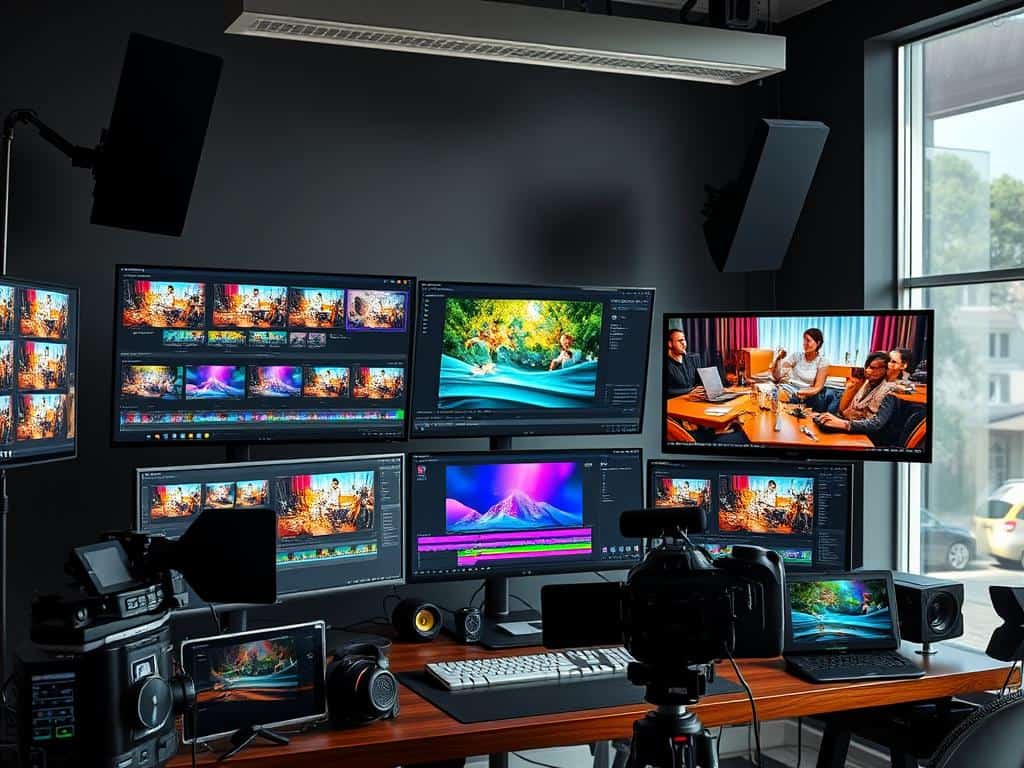Did you know editing is often the longest and most challenging part of making videos? This fact might seem daunting, but it shows how important editing is. It turns raw footage into something amazing. Learning to edit videos well lets you tell stories better and be creative.
As a beginner, I want to make editing easy and fun. With more people wanting great videos online, learning to edit is key. In this guide, I’ll share tips, tools, and methods to help you make stunning videos.
Key Takeaways
- The editing phase is the most time-consuming aspect of video production.
- Recording more footage than needed can prevent issues during the editing process.
- Organizing clips from the shoot is key for efficient editing.
- Color correction and sound design greatly improve your videos.
- Picking the right video editing software is essential for success.
Choosing the Right Video Editing Software
Choosing the right video editing software is key to a good editing experience. There are many options, from paid to free tools. Knowing which one fits your needs can boost your creativity and work efficiency.
Over 20 years, I’ve tried many video apps for personal and review projects. This experience helps beginners find their way in the editing world.
Popular Video Editing Tools for Beginners
Knowing popular video apps makes learning easier. Adobe Premiere Pro is a top pick for pros, known for its powerful features. DaVinci Resolve is a great free choice, with no watermarks, and works on both Windows and Mac.
Free vs Paid Editing Options
Choosing between free and paid editing tools depends on your project and budget. Free tools have useful features, but paid options offer more. Final Cut Pro costs $299.99 and is great for Mac users needing advanced tools.
Clipchamp is free for quick edits and costs $11.99/month for more features. It’s important to compare these options to find the best for your project.
User-Friendly Software Recommendations
Easy-to-use video editing software makes learning simpler. Animotica is a great choice for Windows users, known for its simple design. Wondershare Filmora and iMovie are also good for beginners, with easy effects and fixes.
These tools are easy to use and powerful, making them perfect for new video creators.
Essentials of Video Editing
Video editing uses many techniques to make a final product engaging. Knowing basic editing principles is key to turning raw footage into a story. It’s not just about cutting out unwanted parts. It’s also about adding things that make the viewer enjoy it more.
Understanding Basic Editing Principles
Good video editing starts with solid principles. These rules help shape a story that’s clear and impactful. For example, checking the pace is important. It can change how we feel by speeding up or slowing down the story.
Choosing the right mix of shots, like long and close shots, also makes a big difference. It helps tell the story better.
Organizing Your Footage and Planning
Getting your footage organized is a big part of editing. Having a clear plan for your video helps you focus on key moments. A strong story guides your editing, making it easier to pick the best parts.
By making a shot list, you make sure you have enough footage. This reduces the need for extra shoots.
Techniques for Effective Storytelling
Using different editing techniques can really improve a story. Shots and cuts help scenes flow smoothly, making the story more engaging. Knowing about conflict, stakes, and character changes is also important.

Adding Music and Sound Effects
Music and sound effects are key in video editing. The right music can make viewers feel certain emotions and set the mood. Using royalty-free music and making sure it fits with the visuals can really grab the audience’s attention.
Matching the sound with the story makes the experience more immersive for viewers.
Conclusion
In this guide, I’ve shared key points about starting video editing. It’s important to pick the right software for you. Adobe Premiere Pro, Final Cut Pro, and DaVinci Resolve are great options, each with its own strengths.
Knowing about frame rates and video resolutions is key for quality content. Frame rates like 24 fps, 30 fps, and 60 fps matter. So do resolutions like Full HD and 4K. Also, mastering aspect ratios like 16:9 and 4:3 is important for sharing your work.
Practicing with projects like documentaries or short films helps improve your skills. Video editing is more than just tech; it’s about telling stories. I suggest trying new things, learning always, and seeing video editing as a creative journey.